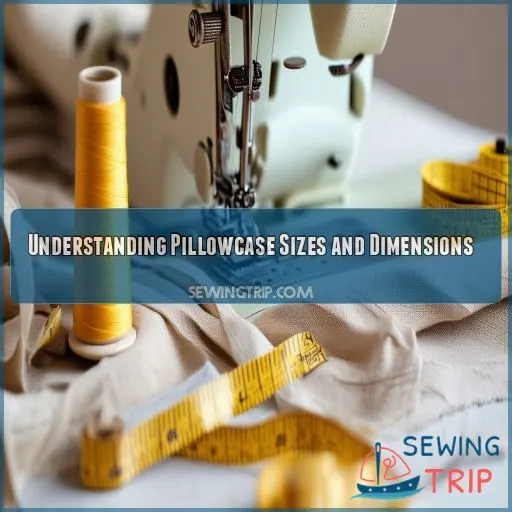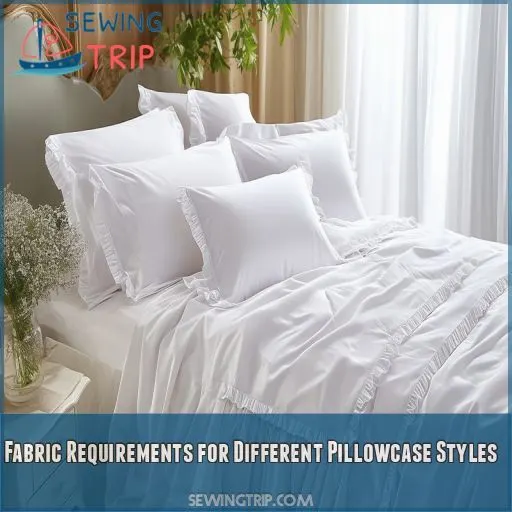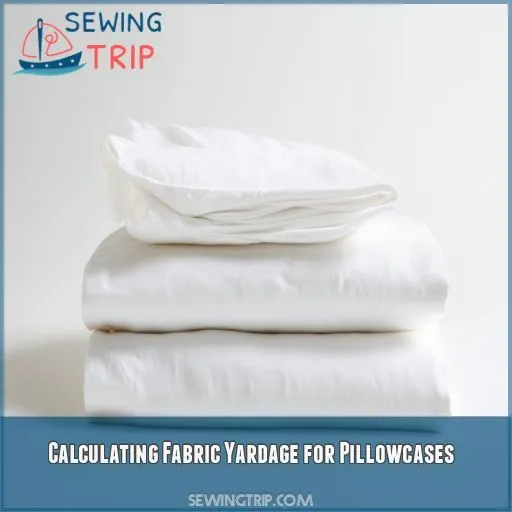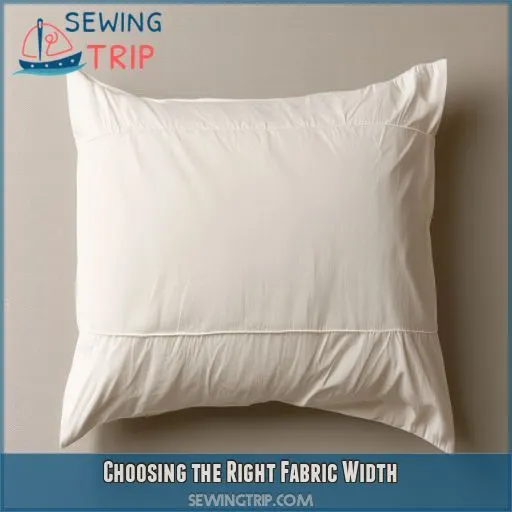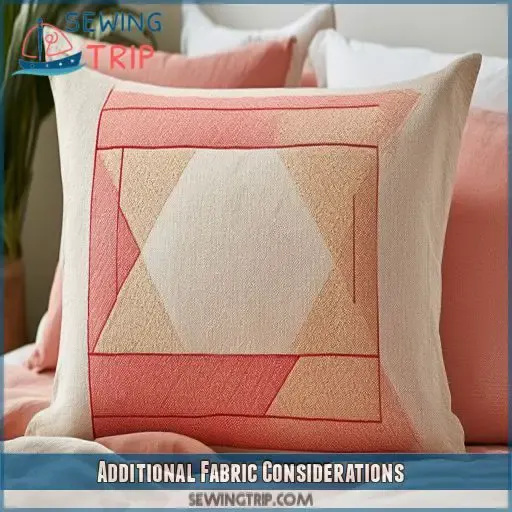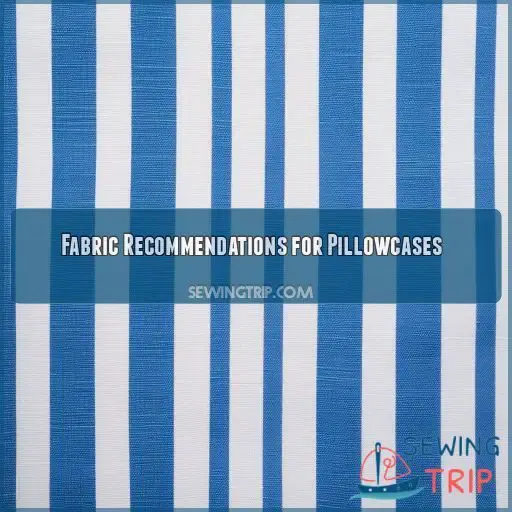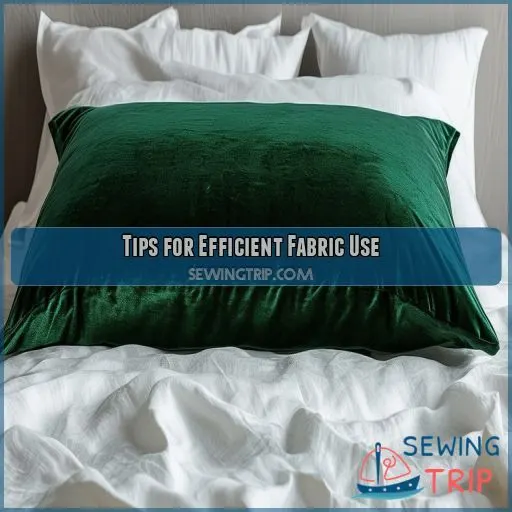This site is supported by our readers. We may earn a commission, at no cost to you, if you purchase through links.
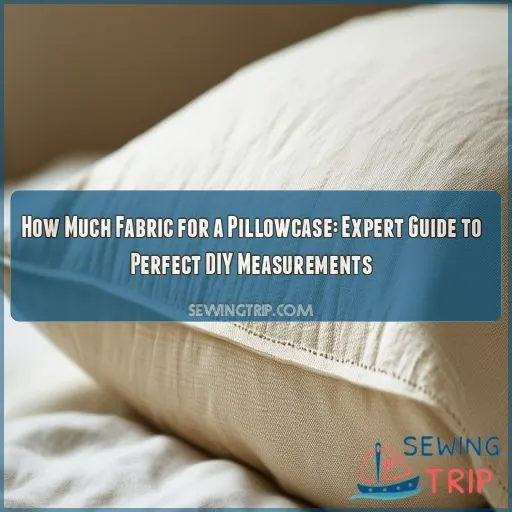 How much fabric will you need for it? Look no further—a go-to expert article that will guide you in the specifics, showing how to make a pillowcase for a standard, queen, or king bed.
How much fabric will you need for it? Look no further—a go-to expert article that will guide you in the specifics, showing how to make a pillowcase for a standard, queen, or king bed.
We will examine how to calculate the yardage needed, how much to allow for shrinkage, and what fabric width will be best. We will also discuss efficient layouts for cutting and suggestions for fabric selection.
Whether you’re a beginner or at an intermediate level in sewing, you will learn exactly how much fabric you need to sew a pillowcase firmly and confidently
Table Of Contents
- Key Takeaways
- How Much Fabric for a Pillowcase?
- Understanding Pillowcase Sizes and Dimensions
- Fabric Requirements for Different Pillowcase Styles
- Calculating Fabric Yardage for Pillowcases
- Choosing the Right Fabric Width
- Additional Fabric Considerations
- Fabric Recommendations for Pillowcases
- Tips for Efficient Fabric Use
- Frequently Asked Questions (FAQs)
- Conclusion
Key Takeaways
- You’ll need about a yard of fabric for a standard pillowcase, but don’t skimp – better to have a little extra than come up short and end up with a pillowcase fit for a Barbie doll!
- Size matters! Standard pillowcases are 20" x 26", queen are 20" x 30", and king are 20" x 36". Remember, your pillow should fit like Cinderella’s slipper – snug but not suffocating.
- Fabric choice can make or break your beauty sleep. Cotton’s a crowd-pleaser, silk’s for the fancy folks, and flannel’s perfect for those chilly nights when you’re counting sheep in your mittens.
- Don’t forget to account for shrinkage, especially with cotton. Add about 10% to your measurements, or you might end up with a pillowcase that shrinks faster than your patience on a Monday morning!
How Much Fabric for a Pillowcase?
To work out the yardage of the fabric you’ll need for a pillowcase, you will typically need about 1 yard for standard or queen size and 1.25 yards for king-size pillows. If you are doing square measures for the main body with extra room for seams and shrinkage, double this amount if you want to create a pair. Add more to your yardage when creating fancier styles like envelopes or French seam pillowcases.
Fabric: The fabric width you are using matters too. 45" fabric will take more yardage than 60" fabric. Pattern matching, and trim or other embellishments might add to your yardage needs.
Stay tuned for more tips on creating a perfect custom pillowcase
Understanding Pillowcase Sizes and Dimensions
When making pillowcases, it’s crucial to understand the dimensions of different pillow sizes that are generally available on the market. A standard size pillow is usually 20" x 26", a queen is 20" x 30", and a king pillow measures 20" x 36". Though manufacturers can have slightly different measurements.
Standard Pillowcase Measurements
When crafting a standard pillowcase, you’ll need to know the right dimensions. Typically, a standard pillowcase measures 20 inches wide by 26 inches long. However, you’ll want to add extra fabric for seam allowances and potential shrinkage.
- Standard pillowcase finished size: 20" x 26"
- Cut fabric size: 21" x 27" (allows for ½" seam allowance)
- Consider adding 1-2" extra for shrinkage, especially with cotton fabrics
Queen Pillowcase Measurements
Queen pillowcases are slightly longer than standard-sized pillowcases. More space for snuggling. Below is an illustration guide of how to measure a queen pillowcase.
| Size | Inches | Centimeters |
|---|---|---|
| W | 20 | 51 |
| Length | 30 | 76 |
| Cuff (if using one) | 4-6 | 10 |
These dimensions work for both envelope closures and zipper closures sewn to your queen pillow. Don’t forget to add extra fabric for decorative stitching or embroidered details!
King Pillowcase Measurements
For a king pillowcase, you’ll need to increase your size. These luxury sleepers measure 20" x 36", so there will be long stretches for sprawling.
From classic to jazzing up with trims, remember that the style of a king pillowcase usually calls for more fabric.
Consider inner flaps or invisible zippers for that polished look, and choose fabrics that will make any user feel like royalty
Fabric Requirements for Different Pillowcase Styles
When considering how much fabric you’ll need for a pillowcase, it’s important to account for the specific style you’re creating. Basic pillowcases require the least fabric, while envelope styles need extra for the flaps, and French seam pillowcases demand additional allowance for their double-folded edges
Basic Pillowcase
To make a basic pillowcase, you’ll need 1 yard of fabric for a standard or queen size, and 1.25 yards for a king size. Cut two pieces: 21" x 32" for standard/queen, or 21" x 42" for king. Sew the pieces together with a 1/2" seam allowance, using straight pins to hold the fabric. Finish the edges with a zigzag stitch to prevent fraying
Envelope Pillowcase
An envelope pillowcase will need more fabric, as it’s made to envelop with inner flaps that close it securely. These envelope models also seem to be more available at what can be counted as reasonable prices than the zippered ones.
Remember to have some extra material because of shrinkage; buy your fabric in about 10 percent more than you’d need.
To finally make those cozy pillowcases one dreams about, it’s a must to iron your fabric before cutting
French Seam Pillowcase
For a French seam pillowcase, you’re likely to take some extra fabric for the seam finish to help with a double layer at the seam edge and extra strength. Factored in should be:
- Fabric shrinkage: 10% more.
- Fabric Width: For 45" or 58" wide fabric, select.
Seam allowances: Include 1/4 and 3/8 inches for the French seam assembly.
Ironing is essential for sharp seams.
Calculating Fabric Yardage for Pillowcases
Fabric yardage for pillowcases would depend on whether you’re making one or a pair, with possible added yardage for shrinkage. For instance, a standard pillowcase is made from approximately 1 yard of fabric, while a pair may take 2 yards. However, always add 10% to your measurements to allow for shrinkage during pre-washing.
Single Pillowcase
For a standard or queen-size pillowcase, you’ll need about 1 yard of fabric. If you want creative closures or decorative stitching, add ¼ yard. If you’re upcycling old linens or doing mixed fabrics, make sure to have the right amount of material needed for your main body and embellishments. Remember, unusual shapes may take more fabric, so measure twice before cutting!
Pair of Pillowcases
For two pillowcases, multiply your yardage requirements by two. Standard or queen sizes use 2 yards of 45" fabric. For a king-size pair, you’d need 2.5 yards. Keep in mind the choice of zipper versus envelope closure and decorative accents. Pattern matching is critically essential for printed fabrics. A great sewing project for beginners!
Accounting for Shrinkage
In calculating the fabric required for pillowcases, add the consideration for shrinkage. Fabrics should have the shrinkage removed beforehand, especially in cotton. You’ll want to increase your measurements by about 10% to account for all shrinkage margins in your calculations.
However, when making allowances for heavier fabric weight and stretch, you’ll need to expect even more shrinkage allowance. For bias cuts, allow even more
Choosing the Right Fabric Width
When choosing your pillowcase fabric, you’d need to note the width. Usually, fabrics are either 45, 54, or 60 inches in width. The width of the fabric you determine would go a long way in letting you know the volume of yardage you’d need to buy, and with all things being equal, wider fabrics can be used to make pillowcases with more yield
45. inch Wide Fabric
Allow for shrinkage and matching patterns when working with 45"-wide cloth to make pillowcases: You’ll need 2 yards to make two pillowcases for a standard or queen size and 2-1/2 yards for the king size.
If the fabric has directional prints or a trim or band, purchase extra fabric.
You may need to use a serger on the seams to get neat edges without serging through the selvages
54. inch Wide Fabric
Whenever working with 54-inch wide fabric for pillowcases, do it efficiently and minimize waste. Consider the following:
- Shrinkage allowance: Buy at least 10% more fabric than the pattern suggests to allow for shrinkage.
- Fabric scraps: Utilize extras for minor assignments or finishes.
- Buying in bulk: Bulk purchasing is time-saving and cost-effective. This also allows you to buy enough quantities that will enable pattern matching.
60. inch Wide Fabric
When working with 60-inch wide fabric, you’ll find it’s a dream for pillowcase projects. This generous width allows you to cut your pieces without worrying about seams running along the length. You’ll save time and fabric, especially when making multiple pillowcases. Plus, 60-inch wide fabric often comes in a variety of prints and textures, perfect for creating unique, custom bedding
Additional Fabric Considerations
That means you have to consider more than just the generic measurements needed in a piece of fabric for a pillowcase. Four fabric elements, placement, directional print, pattern match, and decorative cuffs or trims all add up to consuming more fabric, so planning is critical from the outset.
Directional Prints
Be aware of directional print when cutting out your pillowcase. Directional print requires more fabric, so the print is always going in one direction. Here are some things to think about:
- Choose fabric that obviously has a distinct vertical or horizontal
- Account for extra yardage to match the print
- Align fabric grain with direction of print
• Consider the weight and drape of the fabric for comfort
Pattern Matching
Pattern matching is essential for an even finish. Keep the direction of the pattern in the fabric; consider the scale of the print and color combinations.
This will ensure that a design continues from one side of the seam to another, bringing out the best display in a pillowcase.
Proper placement of fabric avoids mismatching the design, resulting in a unified professional finish
Decorative Cuffs or Trims
Adding decorative cuffs or trims to your pillowcases can elevate their look and feel. Consider these elements when designing your pillowcases:
- Cuff design: Choose a contrasting color or pattern for a striking effect.
- Trim color: Select trims that complement or enhance the main fabric.
- Embellishment options: Incorporate lace, piping, or embroidery for added elegance.
- Fabric texture: Mix different textures for a rich, tactile experience
Fabric Recommendations for Pillowcases
You will also want to explore pillow case fabric options for soft cotton, daily applications, luxurious silk or satin for an elegant feel and look, or cozy flannel during the colder months. Your fabric choice can significantly impact the comfort level and durability of your pillowcases, which is worth researching to find a perfect fit for your needs and preferences.
Cotton Options
When choosing cotton for your pillowcases, you’ve got plenty of options.
Dyed cotton offers a wide range of solid colors, while patterned and printed cotton can add personality to your bedding.
Woven cotton, like percale or sateen, provides different textures.
For eco-conscious crafters, organic cotton is a great choice.
Each option has its unique feel and appearance, so choose what suits your style best
Silk and Satin Choices
Silk gives the most luxurious sheen and smooth drape, while satin provides silky softness. Both fabrics are ultra-breathable and very hard-wearing; hence, they become two of the best materials for pillowcases.
Their feel—the weight of silk and the smoothness of satin—ensures comfort with style and adds dimension to your sleep.
You need only consider one of these fabrics to bring a little luxury into the bedroom
Flannel and Seasonal Fabrics
Flannel is a cozy choice for pillowcases, especially during colder months. Its soft texture and warmth make it ideal for holiday-themed or seasonal prints. You can find flannel in various patterns, from festive designs to winter motifs, adding a touch of seasonal charm to your bedding while ensuring comfort
Tips for Efficient Fabric Use
When creating the pillowcases, use a cutting layout that will allow you the most of your fabric, wasting the least, which can also be utilized to create trims and other decorator touches used on small secondary pieces.
Purchasing the fabric in bulk could also be a money-saving measure, especially for several lots of pillowcases; indeed, the prices tend to drop with volume purchases, bringing consistent quality to all your projects
Cutting Layout Strategies
To maximize cutting efficiency and minimize fabric waste, consider these strategies:
- Layering techniques: Multiple layers of fabric are aligned on top of one another and cut simultaneously.
- Pattern Placement: Align patterns by matching the seaming of patterns to have a continuous and connected look.
Precision measuring: Accurate cuts using rulers and rotary cutters.
- Remnant maximization: Plan cuts to make use of remnants for small projects
Utilizing Fabric Scraps
Don’t let those fabric scraps go to waste! You can utilize remnants for pillowcase accents, like decorative cuffs or piping.
Plan your projects to maximize scrap utilization and reduce waste. Small pieces work great for patchwork designs or appliqués.
Get creative with contrasting fabrics for a unique touch. Remember, every scrap saved is money in your pocket and less fabric in landfills
Bulk Fabric Purchasing
When you’ve mastered using fabric scraps, consider bulk purchasing for even more savings. Many fabric wholesalers and online fabric stores offer discounts for larger orders. Here’s how to make the most of bulk buying:
- Research discount fabric vendors
- Compare prices from multiple fabric outlet locations
- Look for seasonal sales or clearance events
- Consider splitting large orders with fellow crafters
You’ll save money and always have fabric on hand for your pillowcase projects
Frequently Asked Questions (FAQs)
How much fabric do I need to make a standard pillowcase?
You’ll need about 1 yard of fabric for a standard pillowcase. It’s best to get 44-inch wide fabric. Remember to wash and iron it before cutting. This amount allows for seam allowances and potential shrinkage
What is the average size of a standard pillowcase?
A standard pillowcase typically measures 20 inches wide by 26 inches long. You’ll find this size fits most standard pillows snugly. Keep in mind, there’s some variation between manufacturers, but these dimensions are generally consistent across the board
How many yards of fabric do I need for a pillow bed?
You’ll need 2-3 yards of fabric for a pillow bed, depending on its size. For a twin-sized pillow bed, aim for 5 yards. Larger sizes like queen or king will require more fabric. Consider adding extra for seam allowances
How much fabric do I need to cover a 12×12 pillow?
You’ll need about 1/3 yard of fabric to cover a 12×12 pillow. Add an extra inch on each side for seam allowance, making your cut size 14×14 inches. Don’t forget to account for pattern matching if necessary
How much fabric do I need to make 2 pillowcases?
Picture soft fabric flowing through your fingers as you create cozy pillowcases. You’ll need 2 yards for standard or queen-size, 5 yards for king-size pillowcases. Don’t forget to add 10% extra for shrinkage when you’re shopping
How much fabric should I buy for a king size pillowcase?
You’ll need about 25 yards of fabric for a king-size pillowcase. This allows for a 20" x 40" finished size with extra for seams and cuffs. Remember to add 10% for shrinkage if you’re using cotton fabric
How many pieces of fabric do you cut for a pillowcase?
You’ll typically cut two pieces of fabric for a basic pillowcase: one for the main body and another for the cuff. If you’re adding a decorative trim, you’ll need a third piece. Adjust sizes based on your preferred style
How much fabric do I need to make 2 2626 pillows?
You’ll need about 2 yards of fabric for two 26×26 pillows. This allows for a 1/2-inch seam allowance and extra material for the closure. Remember to choose a fabric that’s at least 45 inches wide
How to pre-wash fabric for pillowcases?
Pre-wash your pillowcase fabric in cool water with mild detergent. Wash on its own to prevent dye bleeds—dry low heat or air-dry. Ironing should be done while it’s slightly damp to remove the wrinkles. This process will help avoid shrinkage and give an excellent fit.
What thread type is best for pillowcases?
Silk-smooth or sturdy and strong? You’ll want all-purpose polyester thread for your pillowcases. It’s durable, resists shrinking, and works well with most fabrics. For a luxurious touch, consider cotton thread on high-end cotton or linen pillowcases
How to sew an envelope-style pillowcase?
To sew an envelope-style pillowcase, cut a main piece and two overlapping flaps. Hem the flaps, then pin and sew them to the main piece. Finally, fold the case in half, right sides together, and stitch the sides closed
Can I use patterned fabric for pillowcases?
Yes, you can use patterned fabric for pillowcases. It’s a great way to add personality to your bedding. Choose patterns that complement your room’s decor and consider how they’ll look when paired with your sheets and comforter
How to add decorative trim to pillowcases?
If you’re including decorative trim, this should be sewn onto the edge of the pillowcase before putting it together. Select a ribbon or lace in a contrasting color to match the cuff or opening, pin it in place, and then stitch carefully. You can use piping for a tailored look.
Conclusion
Can you believe that the average man spends about 26 years of his life sleeping? This is just one reason why knowing the size of pillowcase fabric might turn out to be important, not only for reasons of comfort but also for style.
Now you know about pillowcase sizes, fabric requirements, and methods for their calculations. With this guide, you can make custom pillowcases of the correct sizes and just the way you like.
Remember to take into consideration the width of your fabric, shrinkage, as well as design elements as you plan your project.
Happy sewing, and enjoy your cozy, personalized pillowcases!

